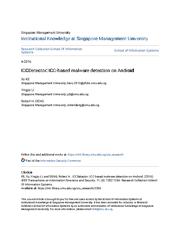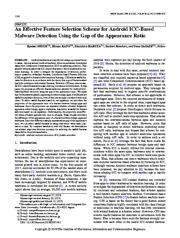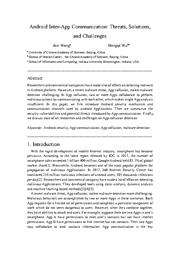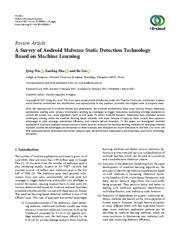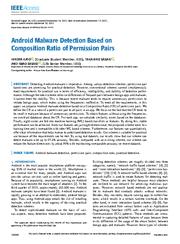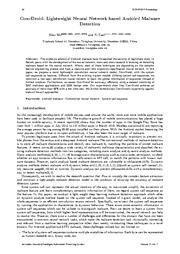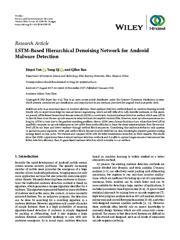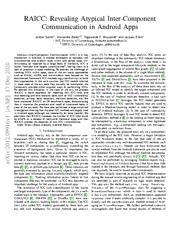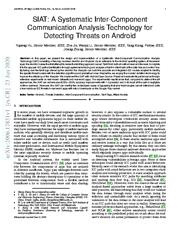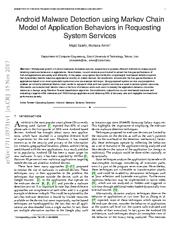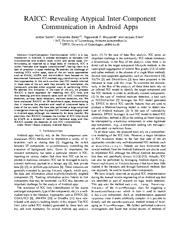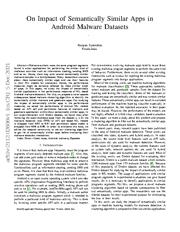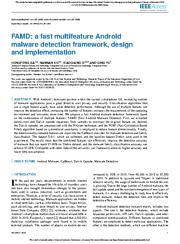A copy of this work was available on the public web and has been preserved in the Wayback Machine. The capture dates from 2020; you can also visit the original URL.
The file type is application/pdf.
Filters
ICCDetector: ICC-Based Malware Detection on Android
2016
IEEE Transactions on Information Forensics and Security
Most existing mobile malware detection methods (e.g., Kirin and DroidMat) are designed based on the resources required by malwares (e.g., permissions, application programming interface (API) calls, and ...
For the detected malwares, ICCDetector further classifies them into five newly defined malware categories, which help understand the relationship between malicious behaviors and ICC characteristics. ...
These works focus on identifying ICC-related attack surfaces for Android apps, while ICCDetector focuses on detecting malwares based on ICC-related features. ...
doi:10.1109/tifs.2016.2523912
fatcat:6c7ldxhkofa2tgxgv62aki27nm
An Effective Feature Selection Scheme for Android ICC-Based Malware Detection Using the Gap of the Appearance Ratio
2019
IEICE transactions on information and systems
Among several Android malware detection schemes, the scheme using Inter-Component Communication (ICC) is gathering attention. ...
That scheme extracts numerous ICC-related features to detect malwares by machine learning. ...
[6] propose the scheme which builds malware detection models based on ICC-related features. ...
doi:10.1587/transinf.2018edp7301
fatcat:ihek6dtrdzco7knquc65osy5hu
Android Inter-App Communication Threats, Solutions, and Challenges
[article]
2018
arXiv
pre-print
Researchers and commercial companies have made a lot of efforts on detecting malware in Android platform. However, a recent malware threat, App collusion, makes malware detection challenging. ...
Finally, we discuss state of art researches and challenges on App collusion detection. ...
[29] propose a malware detection method named ICCDetector, which can detect stealthy collusion attack. ...
arXiv:1803.05039v1
fatcat:5xol7tuek5c6rk5y53xhlykvlu
A Survey of Android Malware Static Detection Technology Based on Machine Learning
2021
Mobile Information Systems
To detect Android malware, researchers have proposed various techniques, among which the machine learning-based methods with static features of apps as input vectors have apparent advantages in code coverage ...
In this paper, we investigated Android applications' structure, analysed various sources of static features, reviewed the machine learning methods for detecting Android malware, studied the advantages ...
leverage on ICC
mechanism for
malware detection. ...
doi:10.1155/2021/8896013
doaj:9dc548d197fd404fbcd4ee962f374bde
fatcat:mbuavifbmzfmjm3shzm4wcbm4a
Android Malware Detection Based on Composition Ratio of Permission Pairs
2021
IEEE Access
Detecting Android malware is imperative. Among various detection schemes, permission pair based ones are promising for practical detection. ...
To meet all the requirements, in this paper, we propose Android malware detection based on a Composition Ratio (CR) of permission pairs. ...
[8] propose a scheme called ICCDetector focusing on the difference of ICC patterns between benign apps and malware. ICC is inner communication among Android system and apps. ...
doi:10.1109/access.2021.3113711
fatcat:neac7cpwkzazdhzpvzembilhkq
ConvDroid: Lightweight Neural Network based Andoird Malware Detection
2019
Australian Journal of Intelligent Information Processing Systems
In Recent years, with the development of the neural network, more and more research is focusing on detecting malware based on the neural network. ...
The explosive amount of Android malware have threatened the security of legitimate users. ...
ICCDetector [24] model ICC patterns to identify malware that exhibits different ICC characteristics from benign apps. ...
dblp:journals/ajiips/WuX19
fatcat:3foe6cioibeqnptbxs35xxlqf4
LSTM-Based Hierarchical Denoising Network for Android Malware Detection
2018
Security and Communication Networks
The results show that HDN outperforms these Android malware detection methods,and it is able to capture longer sequence features and has better detection efficiency than N-gram-based malware detection ...
Most malware detection methods based on machine learning models heavily rely on expert knowledge for manual feature engineering, which are still difficult to fully describe malwares. ...
It is obvious that HDN enhances the detection result compared with -gram model. On the BD2 dataset, we also compare with a novel method based on ICC features called ICCDetector [12] . ...
doi:10.1155/2018/5249190
fatcat:e4wdbwoxjfgrxo4ldxxnkly6mq
RAICC: Revealing Atypical Inter-Component Communication in Android Apps
[article]
2021
arXiv
pre-print
leaks detection, malware detection, etc. ...
We also show that RAICC increases the number of ICC links found by 61.6% on a dataset of real-world malicious apps, and that RAICC enables the detection of new ICC vulnerabilities. ...
ICCDETECTOR [7] , for instance, uses Machine Learning (ML) to detect Android malware. The ML model is built by using ICC-related features extracted with EPICC [8] . ...
arXiv:2012.09916v2
fatcat:jtyjfgbs4jbetn2glhzvul7yoi
Self-protection of Android systems from inter-component communication attacks
2018
Proceedings of the 33rd ACM/IEEE International Conference on Automated Software Engineering - ASE 2018
IccDetector [221] is an ICC-based malware detection in Android. It statically extracts ICC information and uses them as features to train a machine-learning classifier. ...
Detecting and preventing ICC attacks based on RPC or notification-based communications is beyond the scope of this dissertation but indeed an interesting avenue of future work. ...
To address these limitations, this chapter presents a novel machine learning-based Android malware detection and family identification approach, RevealDroid, that operates without the need to perform complex ...
doi:10.1145/3238147.3238207
dblp:conf/kbse/HammadGM18
fatcat:qht4e54ehjfltlht6wjuwzsata
SIAT: A Systematic Inter-Component Communication Analysis Technology for Detecting Threats on Android
[article]
2020
arXiv
pre-print
Moreover, the SIAT can identify two undisclosed cases of bypassing that prior technologies cannot detect and quite a few malicious ICC threats in real-world apps with lots of downloads on the Google Play ...
We implement the SIAT with Android Open Source Project and evaluate its performance through extensive experiments on well-known datasets and real-world apps. ...
ICCDetector [19] builds a model to detect malwares via extracting the ICC features and training with a set of benign apps and malwares. ...
arXiv:2006.12831v1
fatcat:jfpidgnj2jhtznsjz2uywc3tyq
Android Malware Detection using Markov Chain Model of Application Behaviors in Requesting System Services
[article]
2017
arXiv
pre-print
In this paper, we propose ServiceMonitor, a lightweight host-based detection system that dynamically detects malicious applications directly on mobile devices. ...
Widespread growth in Android malwares stimulates security researchers to propose different methods for analyzing and detecting malicious behaviors in applications. ...
ICCDetector [10] is a static based method that extracts ICC (Inter-Component Communication)-related features that hold interactions within or cross applications' components, and then leverage machine ...
arXiv:1711.05731v1
fatcat:7ar5foxp5vcu3g3svih7uygrdi
RAICC: Revealing Atypical Inter-Component Communication in Android Apps
2021
2021 IEEE/ACM 43rd International Conference on Software Engineering (ICSE)
leaks detection, malware detection, etc. ...
We also show that RAICC increases the number of ICC links found by 61.6% on a dataset of real-world malicious apps, and that RAICC enables the detection of new ICC vulnerabilities. ...
ICCDETECTOR [7] , for instance, uses Machine Learning (ML) to detect Android malware. The ML model is built by using ICC-related features extracted with EPICC [8] . ...
doi:10.1109/icse43902.2021.00126
fatcat:ykmowz42kjcrjfidvmy55ecr4a
On Impact of Semantically Similar Apps in Android Malware Datasets
[article]
2021
arXiv
pre-print
In this paper, we study the impact of semantically similar applications in the performance measures of ML based Android malware detectors. ...
= 0) the malware detection rate (TPR) of API call based ML models is dropped from 0.95 to 0.91 and permission based model is dropped from 0.94 to 0.90. ...
Deng, “Iccdetector: Icc-based malware detection
Research in Computer Security, pp. 37–54, Springer, 2012. ...
arXiv:2112.02606v1
fatcat:dh3fa2fkafdnjji63g4myqv2cy
FAMD: a fast multifeature Android malware detection framework, design and implementation
2020
IEEE Access
THE FRAMEWORK OF FAMD FAMD is a fast Android malware detection framework based on multifeature combination. ...
[10] used a variety of dynamic features based on method calls and intercomponent communication (ICC) intents to achieve better robustness than static analysis and dynamic analysis, which depends on ...
doi:10.1109/access.2020.3033026
fatcat:mtj7j5mekngoxoqnivmxtr3qhm
A Preliminary Study On the Sustainability of Android Malware Detection
[article]
2018
arXiv
pre-print
Machine learning-based malware detection dominates current security defense approaches for Android apps. ...
Following these findings, we developed DroidSpan, a novel classification system based on a new behavioral profile for Android apps. ...
ICCDetector [41] distinguishes malware from benign apps based on their different patterns in ICCs. ...
arXiv:1807.08221v3
fatcat:jexir6e6lvbsddcgqmvq4e7ubi
« Previous
Showing results 1 — 15 out of 18 results

